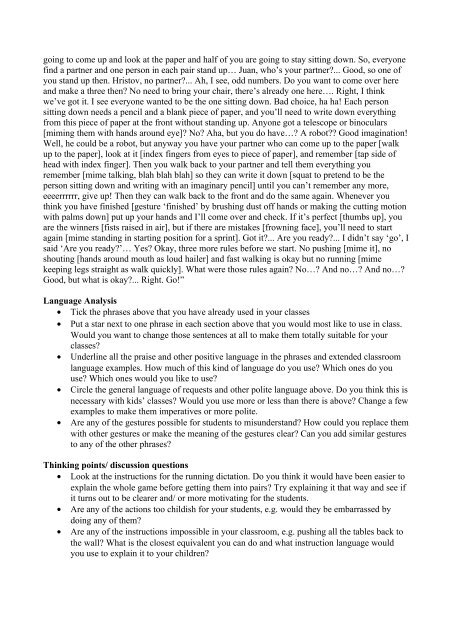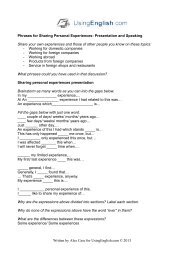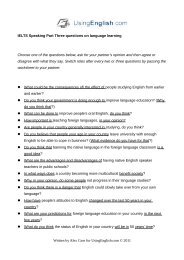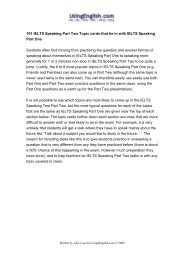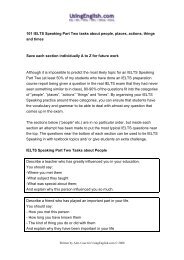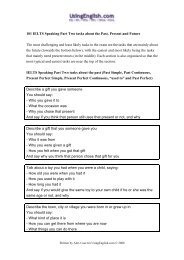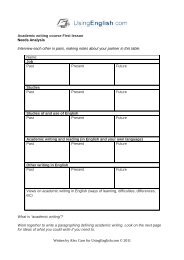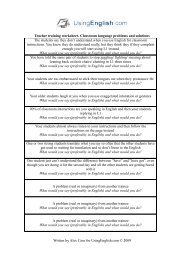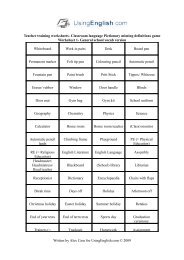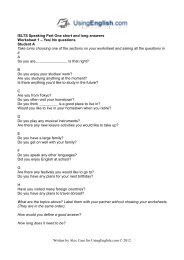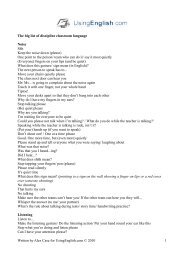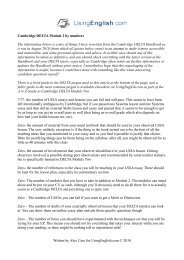Useful classroom language for moving around
Useful classroom language for moving around
Useful classroom language for moving around
Create successful ePaper yourself
Turn your PDF publications into a flip-book with our unique Google optimized e-Paper software.
going to come up and look at the paper and half of you are going to stay sitting down. So, everyone<br />
find a partner and one person in each pair stand up… Juan, who’s your partner?... Good, so one of<br />
you stand up then. Hristov, no partner?... Ah, I see, odd numbers. Do you want to come over here<br />
and make a three then? No need to bring your chair, there’s already one here…. Right, I think<br />
we’ve got it. I see everyone wanted to be the one sitting down. Bad choice, ha ha! Each person<br />
sitting down needs a pencil and a blank piece of paper, and you’ll need to write down everything<br />
from this piece of paper at the front without standing up. Anyone got a telescope or binoculars<br />
[miming them with hands <strong>around</strong> eye]? No? Aha, but you do have…? A robot?? Good imagination!<br />
Well, he could be a robot, but anyway you have your partner who can come up to the paper [walk<br />
up to the paper], look at it [index fingers from eyes to piece of paper], and remember [tap side of<br />
head with index finger]. Then you walk back to your partner and tell them everything you<br />
remember [mime talking, blah blah blah] so they can write it down [squat to pretend to be the<br />
person sitting down and writing with an imaginary pencil] until you can’t remember any more,<br />
eeeerrrrrr, give up! Then they can walk back to the front and do the same again. Whenever you<br />
think you have finished [gesture ‘finished’ by brushing dust off hands or making the cutting motion<br />
with palms down] put up your hands and I’ll come over and check. If it’s perfect [thumbs up], you<br />
are the winners [fists raised in air], but if there are mistakes [frowning face], you’ll need to start<br />
again [mime standing in starting position <strong>for</strong> a sprint]. Got it?... Are you ready?... I didn’t say ‘go’, I<br />
said ‘Are you ready?’… Yes? Okay, three more rules be<strong>for</strong>e we start. No pushing [mime it], no<br />
shouting [hands <strong>around</strong> mouth as loud hailer] and fast walking is okay but no running [mime<br />
keeping legs straight as walk quickly]. What were those rules again? No…? And no…? And no…?<br />
Good, but what is okay?... Right. Go!”<br />
Language Analysis<br />
• Tick the phrases above that you have already used in your classes<br />
• Put a star next to one phrase in each section above that you would most like to use in class.<br />
Would you want to change those sentences at all to make them totally suitable <strong>for</strong> your<br />
classes?<br />
• Underline all the praise and other positive <strong>language</strong> in the phrases and extended <strong>classroom</strong><br />
<strong>language</strong> examples. How much of this kind of <strong>language</strong> do you use? Which ones do you<br />
use? Which ones would you like to use?<br />
• Circle the general <strong>language</strong> of requests and other polite <strong>language</strong> above. Do you think this is<br />
necessary with kids’ classes? Would you use more or less than there is above? Change a few<br />
examples to make them imperatives or more polite.<br />
• Are any of the gestures possible <strong>for</strong> students to misunderstand? How could you replace them<br />
with other gestures or make the meaning of the gestures clear? Can you add similar gestures<br />
to any of the other phrases?<br />
Thinking points/ discussion questions<br />
• Look at the instructions <strong>for</strong> the running dictation. Do you think it would have been easier to<br />
explain the whole game be<strong>for</strong>e getting them into pairs? Try explaining it that way and see if<br />
it turns out to be clearer and/ or more motivating <strong>for</strong> the students.<br />
• Are any of the actions too childish <strong>for</strong> your students, e.g. would they be embarrassed by<br />
doing any of them?<br />
• Are any of the instructions impossible in your <strong>classroom</strong>, e.g. pushing all the tables back to<br />
the wall? What is the closest equivalent you can do and what instruction <strong>language</strong> would<br />
you use to explain it to your children?


